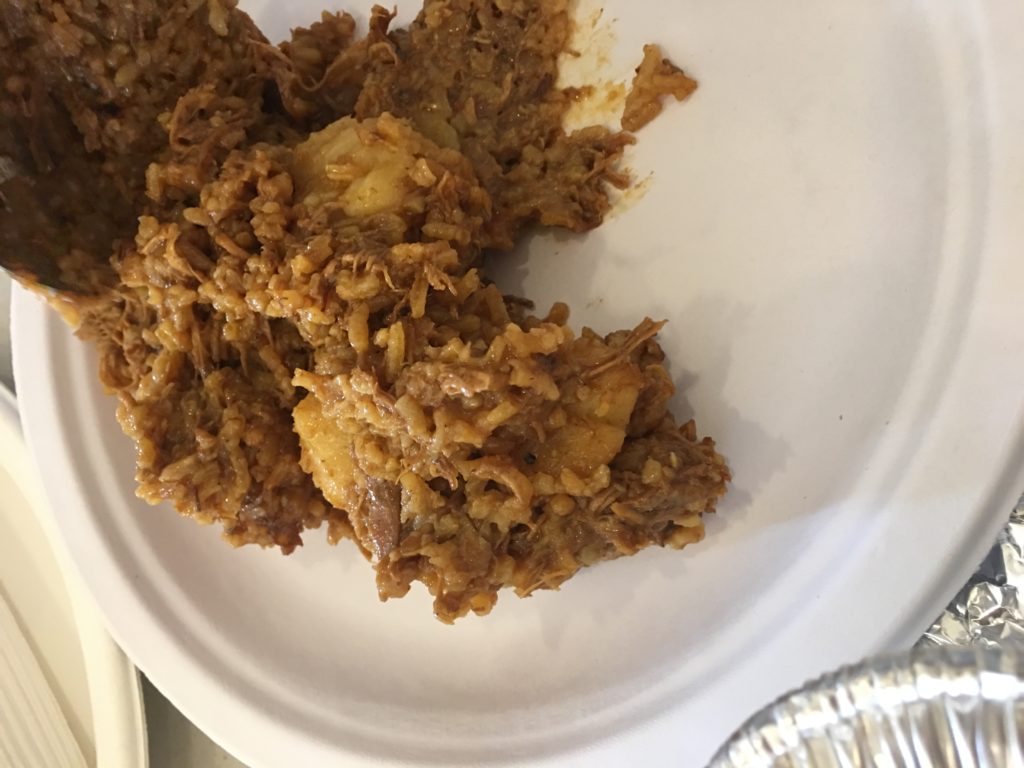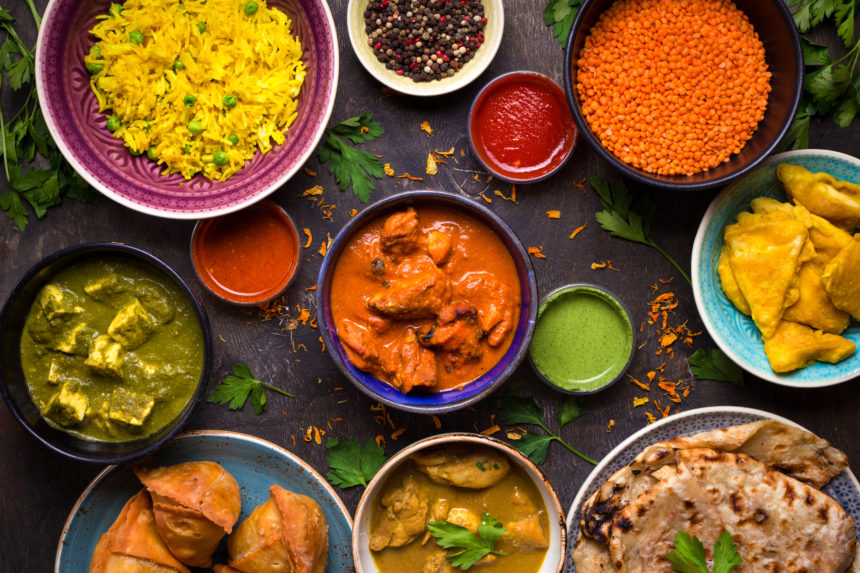Musa really enjoys sampling the exciting flavors that Los Angeles’ different immigrant communities bring to the table. Tasting an unfamiliar dish often inspires him to experiment with a new spice, or try a different way of preparing an old favorite. Cooking is a very positive activity for Musa because the kitchen is a space where he can make his own choices, and be in control of what happens. He likes transforming a pile of raw materials into something new and delicious.
“If you start with a raw onion, it’s just like a hard ball, and it tastes so sharp and hot that it makes your eyes water. Well, you could take a bite out of a raw onion, just as it is, but you can also chop that onion into fine slices, and cook them slowly in hot oil while they first start to brown, and then to melt down almost into a jam. You must keep stirring and stirring, to keep this from burning, and if you have patience enough, the harsh raw onion is totally changed into something so sweet and good! I like the feeling that I’m the one making things like this happen, so I really like to cook. The kitchen becomes my very own world, and I get to be in charge!”
On a chilly evening recently, he found himself craving a homey Chicken Pilau, like those he’d eaten back in Uganda. The memories of tender chicken browning with some smoky-sweet caramelized onions, and warmed with spices like ginger, garlic and cumin made his mouth water, and remembering how fluffy and flavorful some rice and potatoes could stew up in a pot of this awesome sauce made him want to head to the stove!
There was only one problem; while he’d eaten LOTS of pilau, and seen it being cooked back at home once in a while, he’d never actually made it himself. Well, he wasn’t going to let that hold him back. There had to be some recipes and videos for Pilau on the internet, so Musa started Googling, and….WOW. It turns out that Chicken Pilau is a real favorite throughout the African continent, and for every different region, there’s a special combination of spices, textures and ingredients that make it taste just like home to the people who prepare it. Some Tanzanian-style Pilaus call for cooking in ghee, along with garam masala, and coconut milk. A Kenyan-style Pilau sautés its ginger, garlic, and cumin in oil, but adds no potatoes into the mix. From Zanzibar, one recipe includes potatoes, but also throws in a chopped apple and some raisins for sweetness. Some recipes add tomatoes, some leave them out. Peas, or green peppers, or yogurt might appear in – or disappear from – the dish, according to the region. Sometimes there is cinnamon and cardamon joining the spicy mix, sometimes it’s a big dash of hot chilies instead. There are some constants that are shared throughout these different versions of Pilau; it must have long grained rice, some juicy chicken thigh or leg meat stewed into it, and it needs lots and lots of those jammy-sweet, deeply browned onions!
His Imaginary Pilau Tasting Party set Musa up with a solid game plan for the needed times, temperatures, and how much of what needed to go into the pot just when, in order to get the results he was hungry for. The wide range of possible spice combinations and additions (potatoes and tomatoes definitely yes, but coconut milk or apples…. maybe not tonight?) hinted that he could be more flexible with the ingredients than he first supposed. Pilau seems to urge a little inspired improvisation, as the onions and garlic are chopped, and the spice packets come out of the cupboard. Being able to adapt this dish to what’s fresh, tasty, and most easily available is one reason it’s so popular across Africa. The delicious meal that results from giving simple ingredients a little time and space to cook together in ways that really bring out their best qualities is another.
Here’s the Ugandan-style Pilau that Musa likes to cook up to warm himself and his friends and family on chilly days: Enjoy!

Ingredients:
- mild-tasting oil for sautéing (This time, Musa had olive oil on hand, so he used that.)
- 2-3 good sized onions, thinly sliced (Red onions were available, so in they went! This may seem like a lot of onions, but they cook WAY down.)
- 1 or 2 lbs boneless, skinless chicken thighs. (How much chicken do you feel like having/do you happen have in the fridge tonight?)
- 6 roma tomatoes, cut into dice. (If you don’t have these, 3 -4 Tbs of tomato paste also work.)
- 2-4 russet potatoes, cut into large chunks. (Russets will melt down almost completely into the Pilau as it cooks. If you prefer to be able to identify whole pieces of potato in the finished dish, try using red bliss potatoes instead.)
- Spices and seasoning: For Musa, these can vary from time to time, as he enjoys experimenting with new flavors. You can add more or less to suit your own preferences, but here are some general guidelines to start with.
- Garlic: 2-4, or however many you like of fresh garlic cloves, minced or grated. (serving a side dish of chopped parsley salad with lemon, olive oil, and tomatoes is a breath freshening counterweight to garlic enthusiasm. Try it!)
- Ginger: Musa likes to use a lot, because of its warmth and perfume. 2” piece of ginger root, peeled and grated.
- Turmeric: 1 tsp gives a beautiful golden color and a mysterious touch of astringency
- Cinnamon: 1 2” sized whole stick, or 1/2 tsp ground, for sweetness, & more perfume!
- Cumin: 1-2 tsp ground cumin. Warm, earthy, fragrant, delicious! Take a sniff of this spice, and decide how much feels right tonight!
Other possibilities:
- 1/2 tsp. whole allspice berries: these went in the latest version – an excellent, subtle flavor!
- 1/2 tsp ground cardamon
- 1/2 tsp ground coriander
- a little soy sauce: can add some deep, intriguing, savory flavors. Worth a try, if you like it.
- some dried red chili pepper flakes, if you enjoy turning up the heat along with your spice. bonus: using chipotle chili flakes will give your dish some smoky flavor!
- Salt & Pepper to taste
- Long grain rice – basmati or jasmine. For every 1 cup of rice, remember that you will need to add 2 cups of chicken stock or water to cook it properly. So, if using 2 cups of rice, you need 4 cups of liquid. Soak and then drain the quantity of rice you plan to use at least twice in a bowl of cold water first, to rinse off excess starch.
- Chicken stock, or water; see quantities as above.
Directions:
- Take a large, lidded dutch oven, or stock pot, and add in enough oil to generously film the bottom – leave no dry spots in the pan! Put the pot on the stove at a medium flame to get it good and hot, then add your sliced onions and listen to them sizzle! Stir to distribute the onions over the bottom of the pan, exposing them as an even layer to the heat and oil. Watch around the edges of your layer of onions to see them start to turn a little golden and crispy looking, and then you can stir everything around. Now sprinkle a little salt over the onions to help pull even more moisture out, and stir them again. As the liquid in the raw onion starts evaporating, you will notice how they begin to shrink down, going first a little transparent, and then yellowing into gold. That is because the sugar in the onions is starting to become more concentrated. This sweet/smoky flavor is exactly what you’re aiming for, but the more concentrated the sugars become, the easier it will be to stick and burn them to the bottom of your pot! As their color deepens, and the liquid around them turns thick and syrupy looking, you’ll need to keep those onions moving constantly. Stand over the stove and stir, stir, stir! Adjust the heat so that you can see the onions growing steadily more brown as you move them, but not darkening so quickly that it feels like some areas of the pan are starting to stick before you can get the spoon there to save them. Here are some pictures to give you an idea of just how brown you want these onions to get: This impressive deep mahogany color is key to your Pilau’s flavor!
- Season your chicken thighs generously with salt and pepper. Add another tablespoon or two of oil to the pan to keep the stew moving easily over the bottom of the pot, and throw the chicken into the hot onion/oil mixture. Stir briskly to distribute everything, and let the chicken meat brown on all sides, turning as necessary.
- Check to see if there’s still some hot oil sizzling in the pan – the chicken will have absorbed much of it. Add a little more oil, if necessary, and then stir in the dry spices, turning everything over to mix them in well. Inhale deeply to enjoy the fragrances! Check out the changing colors! Isn’t turmeric beautiful?
- Add the garlic and ginger, and stir throughout the mixture. Use your nose again to sense how the heat tames raw smells into mellow, tantalizing aromas!
- It’s tomato time! In go the chopped romas, or the tomato paste. (If using tomato paste, you can put in a little water or chicken broth to help add some moisture.) Cook tomatoes in the heat until they break down and are distributed through the mix.
- Lastly, in go the potatoes, the rice, and the Chicken broth.(Remember, for every 1 cup of rice, you’ll need 2 cups of liquid) Stir around, turn up the heat, and bring all this to a boil. Taste the liquid for seasoning. Need salt? Put some in. Want more garlic? Now’s a good time! Did you remember the cinnamon stick? In it goes!
- Turn the heat to a low setting, put the cover on the pot, and allow the Pilau to cook gently for 30 minutes. Try not to peek! The rice and potatoes are steaming to a glorious tenderness inside that sealed pot.
- Serve up some delicious Ugandan-style Pilau!

